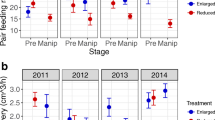Summary
We use contemporary life history theory to analyze parental decisions concerned with the defense of offspring, and with the provisioning of offspring in the presence of risk. In achieving the optimal level of parental investment, the parent faces a tradeoff between present and future reproductive success. Our models, which are based on stochastic dynamic programming, lead to predictions of the following kind: (i) offspring will be defended more vigorously as they grow older; (ii) long-lived species will accept fewer risks in caring for offspring than short-lived species; (iii) parents living in permanently riskier environments will defend their offspring more vigorously than parents in less risky environments; (iv) however, temporary increases in risk will result in temporarily less vigorous defense and provisioning of offspring. The models also show that parents and their offspring have different conceptions of the optimal level of parental investment. The flexibility of our modeling approach as a method of analyzing facultative behavior is also emphasized. Finally, we apply the methods of this paper to analyze fledging behavior of Atlantic puffins.
Similar content being viewed by others
References
Andersson, M., Wiklund, C.G., and Rundgren, H. (1980) Parental defence of offspring: a model and an example.Anim. Behav. 28, 536–42.
Ashcroft, R.E. (1976) Breeding biology and survival of puffins. D. Phil. thesis, Univ. of Oxford.
Bellman, R. (1957)Dynamic Programming. Princeton University Press, Princeton, NJ.
Breitwisch, R. (1988) Sex differences in defence of eggs and nestlings by Northern mockingbird,Mimus polyglottis.Anim. Behav. 36, 62–72.
Charnov, E.L. (1982) Parent-offspring conflict over reproductive effort.Amer. Nat. 119, 736–37.
Clark, C.W. and Levy, D.A. (1988) Diel vertical migrations by juvenile sockeye salmon and the antipredation window.Amer. Nat. 131, 271–90.
Coleman, R.M., Gross, M.R., and Sargent, R.C. (1985) Parental investment decision rules: a test in bluegill sunfish.Behav. Ecol. Sociobiol. 18, 59–66.
Curio, E. (1987) Brood defence in the great tit: the influence of age, number and quality of young.Ardea 75, 35–42.
Curio, E., Regelmana, K. and Zimmerman, U. (1985) Brood defence in the great tit (Parus major): the influence of life history and habitat.Behav. Ecol. Sociobiol. 16, 273–83.
Dijkstra, C. (1988) Reproductive tactics in the kestrelFalco tinnunculus. Ph.D. thesis, Rijksuniversiteit Groningen.
Harris, M.P. (1980) Breeding performance of puffinsFratercula arctica in relation to nest density, laying date, and year.Ibis 122, 193–209.
Harris, M.P. (1984)The Puffin. Poyser, Caltan.
Houston, A.I. and McNamara, J.M. (1987) Singing to attract a mate — a stochastic dynamic game.J. Theor. Biol. 129, 57–68.
Kilpi, M. (1987) Do herring gulls (Larus argentatus) invest more in offspring defence as the breeding season advances?Ornis Fenn. 64, 16–20.
Knight, R.L. and Temple, S.A. (1986) Nest defence in the American goldfinch.Anim. Behav. 34, 887–97.
McLean, I.G., Smith, J.M.N. and Stewart, K.L. (1986) Mobbing behaviour, nest exposure and breeding success in the American robin.Behaviour 96, 171–86.
Mangel, M. (1987) Oviposition site selection and clutch size in insects.J. Math. Biol. 25, 1–22.
Mangel, M. and Clark, C.W. (1986) Towards a unified foraging theory.Ecology 67, 1127–38.
Mangel, M. and Clark, C.W. (1988)Dynamic modeling in behavioral ecology. Princeton University Press, Princeton, N.J.
Nettleship, D.N. (1972) Breeding success of the common puffin [Fratercula arctica (L.)] on different habitats at Great Island, Newfoundland.Ecol. Monog. 42, 239–68.
Parker, G.A. (1984) Evolutionarily stable strategies.Behavioral Ecology. J.R. Krebs and N.B. Davies (eds.), pp. 30–61. Sinauer, Massachusetts.
Snow, D. (1976)The web of adaptation. Quadrangle, New York, NY.
Trivers, R.L. (1974) Parent-offspring conflict.Amer. Zool. 14, 249–64.
Ydenberg, R.C. (1989) Growth-mortality trade offs and the evolution of juvenile life histories in the Alcidae.Ecology (in press).
Ydenberg, R.C. and Clark, C.W. (1989) Aerobiosis and anaerobiosis during diving by Western grebes: an optimal foraging approach.J. Theor. Biol. (in press).
Author information
Authors and Affiliations
Rights and permissions
About this article
Cite this article
Clark, C.W., Ydenberg, R.C. The risks of parenthood. I. General theory and applications. Evol Ecol 4, 21–34 (1990). https://doi.org/10.1007/BF02270712
Issue Date:
DOI: https://doi.org/10.1007/BF02270712




